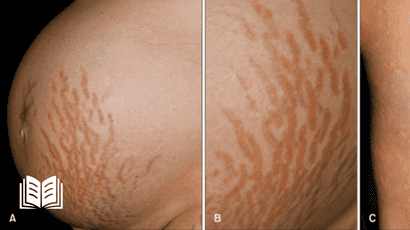Polymorphic eruption of pregnancy is an itchy, bumpy rash that starts in the stretch marks of the abdomen in the last 3 months of pregnancy then clears with delivery. It is also called PUPPP or Pruritic Urticarial Papules and Plaques of Pregnancy.
Polymorphic eruption of pregnancy occurs in about 1 in 160 pregnancies. The risk is greater with excessive weight gain, including multiple births (eg twins or triplets) and more common in women with white skin than women with black skin.
Table of Contents
Symptoms of Polymorphic eruption of pregnancy
It look and feel a lot like hives. Here are some signs that you may have this condition:
- Scattered, itchy bumps appear on or near the stretch marks on your belly, sometimes forming raised patches of skin, or a rash.
- The rash spreads to your thighs, butt, breasts, and arms.
- On skin with less melanin, the bumps or patches may look pink or red.
- On skin with more melanin, the bumps or patches may be the same color as your skin or a darker shade of your skin tone.
- The itching from your rash makes it tough to focus on daily activities and interferes with your sleep.
- There’s no sign of the rash in the area circling your belly button.
Causes of Polymorphic eruption of pregnancy
This condition is thought to be related to stretching of the skin on the abdomen. The stretching elicits an immune response due to connective tissue damage. Supporting the stretch mark theory are the following observations:
- Most cases begin in the last 3 months, especially in the last 5 weeks when the stretching is greatest.
- Triplet pregnancies have a higher risk (14%) than twin pregnancies (2.9%).
- The rash usually starts in the stretch marks around the umbilicus where stretching of the abdomen is greatest.
Another study considers low-level traffic of fetal cells within the mother’s circulation, which appears increased in women with polymorphic eruption of pregnancy, and may persist for some time after the baby is delivered.
You can also read about symptoms and causes of Hyperemesis gravidarum (severe morning sickness in pregnancy)
Risk factors of Polymorphic eruption of pregnancy
Some pregnant women are more likely than others to experience Polymorphic eruption of pregnancy. The following are some of the risk factors:
- being Caucasian
- being pregnant with a boy
- a first pregnancy
- maternal hypertension (high blood pressure)
- multiples pregnancy
- rapid or higher-than-usual weight gain in pregnancy
- It is more commonly reported in women with white skin than in women with black skin
Some pregnant women will experience this rash regardless of the above risk factors.
Complication of Polymorphic eruption of pregnancy
As this rash has no noticeable complication on the mother and the child. Rarely, the child can be born with a mild form of polymorphic eruption of pregnancy rash but this fades as soon as possible. It does not cause any other problem for the baby nor the mother.
You can also read about risk factors and complications of Oligohydramnios (amniotic fluid deficiency)
Prevention of Polymorphic eruption of pregnancy
You can’t prevent this rash, but you can soothe your symptoms until it goes away on its own. Talk to your doctor about safe ways you can manage the itching until your rash disappears before or after pregnancy.
Diagnosis of Polymorphic eruption of pregnancy
Your doctor will perform a physical exam to see if you have this rash. If there’s a question about whether you have it or a different skin condition, your healthcare provider might order tests to confirm. These tests include:
- Complete blood count.
- Liver function test.
- Serum cortisol test.
- Serum hCG test.
- Metabolic panel.
In rare cases, your doctor may order a biopsy to test for skin sample. This test is called a direct immunofluorescence test
You can also read about Prevention and diagnosis of preeclampsia
Treatment of Polymorphic eruption of pregnancy
The natural cure for this rash is delivering your baby. Normally after you give birth, this rash will go away within one to two weeks. But some women may find that the rash persists for a few weeks after delivery.
In the meantime, you can manage your symptoms by trying some of the following methods:
- Moisturizers. You can apply itch-relieving moisturizers to your skin as much as relieves your discomfort. Avoid moisturizers that have ingredients that aren’t baby-friendly. Examples include salicylic acids, retinol, vitamin A, retinyl-palmitate, and tropic acid.
- Topical steroids. A steroid-containing cream, such as a 1 percent hydrocortisone cream, applied to any patchy areas can help to reduce itching. While these creams are largely considered harmless during pregnancy, always check with your doctor before using them. Your doctor may also prescribe topical steroids that are stronger.
- Antihistamines. These medicines can relieve itch, but always check with your doctor before taking them. Examples of medications that are generally thought to be safe during pregnancy include diphenhydramine (Benadryl) and cetirizine (Zyrtec). These medications have been studied in greater detail than other antihistamines.
- Itch-relieving baths. Taking an oatmeal or baking soda bath can help to reduce the itching associated with the rash. A cool, wet compress might also help. Although it can be difficult, avoid scratching the rash when possible. Doing this will likely only make the rash symptoms worse.
In rare cases, your healthcare provider might recommend an oral steroid to relieve pain and itching associated with the rash. These are usually prescribed for women who have severe symptoms associated with the condition, involving intense itching and general discomfort.
- List of Common Diseases & Medical Disorders
- Buy Complete Premium Anatomy Notes (PDFs)
- Medmichihealthcare New posts
- Read All causes of disease short notes
- Read All diagnosis of disease short notes
- Read All treatment of disease short notes
- Subscribe Medmichihealthcare YouTube channel
Discover more from Medmichihealthcare
Subscribe to get the latest posts sent to your email.
